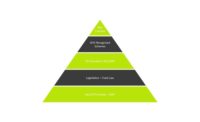In this issue of Food Safety Magazine, we are pleased to welcome Dr. Powitz as a regular contributing columnist and editorial advisor to the publication. His many years of active involvement and leadership in food safety and environmental health issues will be an asset to FSM readers. Dr. Powitz welcomes reader questions and queries for discussion in upcoming columns. Feedback or suggestions for topics you'd like to see covered can be sent to him directly at sanitarian@juno.com or through his website at www.sanitarian.com.
When I decided that I would venture into forensics on a full-time basis, I had no idea what I was getting myself into. My entire professional life had been that of a sanitarian. I felt quite confident about my knowledge and skills; I was well-credentialed and the product of one of the finest schools of public health in the nation. With 25 years of experience, I was both ready and confident about my new vocation. After all, I always felt more comfortable in the field than behind a desk, and I saw this as a perfect opportunity to really use everything I had learned.
It was then I realized how little I actually knew about quality control, sampling, inspecting and instrumentation. While attorneys did not know much about what I do in environmental health and food safety, they do know how to ask the right questions. It was these questions that forced me to reflect on all that my fellow professionals do in the field of disease prevention and to correct the mistakes and misinformation that I had amassed along the way.
In this new column, I will try to present new ways of looking at the tools and techniques we use daily in our quest to ensure safe food. I hope you will take the opportunity to send in questions and comments. I would like to begin by introducing an excellent new glossary of terms that we use in our industry, so that we are all reading from the same page.
Four years ago, I was asked to serve as an expert in a case involving a dairy plant worker whose arm was amputated by a product-filling and packaging machine. The injured worker filed a suit against the machine's manufacturer for negligence, alleging unsafe design of the unit. Apparently, the amputation occurred when the worker reached into the unit while it was in operation to remove several empty paper containers that had slipped from the conveyor. The sleeve of her jacket caught between the conveyor chain and drive sprocket, resulting in this devastating injury.
The plaintiff's attorney produced several industrial hygienists and occupational safety experts who testified to the lack of machine guarding and absence of an emergency cutoff switch on the machine's access panel; even though an emergency cut-off red panic-button switch was readily accessible to the operator. The defendant's attorney (representing the machine's manufacturer) narrowed his argument down to three salient factors. First, that the filling machine had been manufactured in accordance with all applicable consensus standards for food equipment. Second, that the injury occurred in the "food zone" where permanently attached pinch-point machine guarding is not normally installed because it would prevent adequate in-place cleaning. Finally, that in-place cleaning requires that the machine is operational with the access panel removed, so that the conveyor, belt and sprocket can be advanced to allow for the cleaning and sanitizing of all surfaces in the food zone. Since access to the food zone is essential during cleaning, a cut-off switch on the access panels would be have been both inappropriate and certainly ill advised.
Working on behalf of the defendant, I knew that I had to find documentation to support these positions, and I turned to a number of National Sanitation Foundation International (NSF)/ANSI equipment standards, a copy of current Good Manufacturing Practices (cGMPs) and the U.S. Food and Drug Administration (FDA) Food Code for corroboration. During the deposition, it became quite apparent that the key to a solid defense rested on the definition of "food zone" and its interpretation with regard to machine guarding, accessibility and cleaning practices. This definition appeared in several standards, where it was applied to a number of different food-related machine configurations. In each instance, the definition, along with its interpretation, was consistent.
Through subsequent testimony by both an accident reconstructionist and me, a forensic sanitarian, the defendant's counsel convinced the jury that the machine in question did indeed comply with industry standards and did not violate any regulations, including those found in the Occupational Safety and Health Act. As an aside, he also was instrumental in convincing the court of the value of a sanitarian's expertise in matters of this type, but that is another story. Needless to say, the outcome of this trial taught us a powerful lesson: The more precise we are with the definitions we use in our enforcement, education and consultative efforts, the easier it is to gain compliance, understanding and change.
For this reason, we recommend that everyone who routinely works in food safety obtain a copy of the newly published Glossary of Food Equipment Terminology NSF/ANSI 1702002, available through the NSF (www.nsf.org). The forward of this document states: "The purpose of this Glossary is to provide a single resource containing all of the technical terms used in all NSF Food Equipment Standards.... In addition, the Glossary of Food Equipment Terminology may serve as a reference tool within the industry." This last sentence certainly includes all of us.
To illustrate this point, we all have either conducted or been subjected to a regulatory inspection, or we have been part of a quality assurance team and developed Hazard Analysis Critical Control Points (HACCP) programs and quality control protocols. More often than not, we see words and terms used in these documents that do not really fit into the context. Terms are misused, making the meaning of the document somewhat confusing. We are all guilty parties. The quality, more so than the detail, can become quite critical if these documents are ever used in litigation. For example, we've seen the following words and phrases used out of context, erroneously or inappropriately on numerous occasions: "accessible and readily accessible," "bain-marie," "easily cleanable," "in-place cleaning," "non-work surface," "supplemental flooring" and "water station." Gotcha thinking, huh?
The heart of a regulatory inspection or a HACCP program lies in the handling and safety of potentially hazardous foods, and most of us feel quite comfortable identifying these foods. However, did you know that its definition not only includes food types that will support the growth of microorganisms, but also those that do not? In fact, the actual definition is a real eye-opener and may put an additional spin on our work.
When I first received my copy of the Glossary, I immediately went to the section on "zones" (3.223). I could only reflect that it would have been so much easier to develop a convincing argument if the Glossary had been published before my client went to court. Just to let you know, there are seven categories listed under "zone" including: exterior, food, heated food, nonfood, power, refuse contact and splash.
Reading through the Glossary's 223 definitions, including sub-categories to many definitions, is an education in food safety. These terms are used in numerous public health-related equipment standards, and in one way or another each definition relates to some aspect of contamination control, even those components that we take for granted and those that remain unseen. The Glossary is therefore an excellent reminder of the many hidden physical hazards in foodservice operations. For those of us in the regulatory community, this should be part of our everyday reference library. And, for those of us in food production and retail, the Glossary is an excellent adjunct to better understanding the principles and effective application of HACCP and cGMPs. In short, this volume is a good tool because you will never know when it will come in handy.
Forensic sanitarian Robert W. Powitz, Ph.D., MPH, RS, CFSP, has joined the Editorial Advisory Board for Food Safety Magazine. He is principal consultant and technical director of Old Saybrook, CT-based R.W. Powitz & Associates, a professional corporation of forensic sanitarians who specialize in environmental and public health litigation support services to law firms, insurance companies, governmental agencies and industry. For more than 12 years, Powitz was the Director of Environmental Health and Safety for Wayne State University in Detroit, MI, where he continues to hold the academic rank of adjunct professor in the College of Engineering. He also served as Director of Biological Safety and Environment for the U.S. Department of Agriculture at the Plum Island Animal Disease Center at Greenport, NY.
Among his honors, Powitz was the recipient of the NSF/NEHA Walter F. Snyder Award for achievement in attaining environmental quality, and the AAS Davis Calvin Wagner Award for excellence as a sanitarian and advancing public health practice. He is the first to hold the title of Diplomate Laureate in the American Academy of Sanitarians, and also is a Diplomate in the American Academy of Certified Consultants and Experts and with the American Board of Forensic Engineering and Technology. He is licensed to practice as a sanitarian in several states and holds credentials in numerous environmental health and safety specialty areas including food safety, water quality, hazardous materials management, industrial hygiene,biological safety, home inspection, health care safety and environmental assessment.




